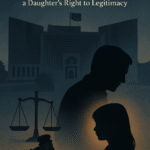A Chilling Confession in Islamabad
Hello, everyone! Imagine a peaceful morning in Islamabad on May 22, 2018, when a man approached a patrolling officer with a horrifying confession: he had killed his own wife. This is the story of Muhammad Ramzan, a case that spiraled from a shocking admission into a high-stakes legal battle before the Supreme Court of Pakistan. Was there more to this story, or was Ramzan truly a cold-blooded killer? Brace yourself—this tale is full of twists that will leave you stunned.
The Fateful Morning in Dhok Maleyar
Let me set the scene. Muhammad Ramzan, a man in his late 30s, lived in Dhok Maleyar, an old neighborhood in Islamabad. He shared a small rented house with his wife, Mst. Ameen Bibi (also known as Yasmeen). On the surface, their life seemed ordinary—but beneath it, tensions simmered.
Then, at 3:00 AM that morning, the unthinkable happened.
According to police reports, Ramzan approached Assistant Sub-Inspector (ASI) Dilawar Hussain during a patrol on Dhodana Link Road. In a trembling voice, he allegedly confessed:
-
He had strangled Yasmeen.
-
He drugged her with pills.
-
He then hid her body in an iron box.
The officer was stunned. Was this a genuine confession, or was Ramzan hiding something darker?
The Investigation Unfolds
Police acted swiftly. Ramzan was arrested and led officers to his home, where they discovered Yasmeen’s lifeless body inside a locked iron box. A rope was around her neck, and her mouth was sealed with off-white tape. The scene was gruesome.
An FIR (First Information Report) was filed under Section 302 (murder) of the Pakistan Penal Code. The police claimed Ramzan suspected Yasmeen of “immoral conduct”—but no evidence supported this motive.
At first, the case seemed airtight:
✔ A confession
✔ A body
✔ A clear suspect
But as the investigation progressed, cracks began to appear.
The Legal Battle Begins
Ramzan pleaded not guilty, claiming he never confessed. Instead, he told a different story:
-
Unidentified assailants had killed Yasmeen early that morning.
-
He rushed to the police station to report the crime—only to be framed.
The Sessions Court of Islamabad West heard testimony from 11 prosecution witnesses, including:
-
ASI Dilawar Hussain (who recorded the alleged confession)
-
Inspector Abdul Rehman (who handled the crime scene)
The prosecution relied heavily on:
-
The FIR, which they claimed was Ramzan’s confession.
-
The recovery of Yasmeen’s body from the iron box (allegedly on Ramzan’s direction).
But the defense spotted critical flaws.
A Shocking Conviction—And an Appeal
On September 10, 2018, the Sessions Court convicted Ramzan, sentencing him to death and ordering him to pay 2 lakh rupees in compensation to Yasmeen’s family.
Ramzan appealed to the Islamabad High Court, but on February 22, 2022, the court upheld the conviction. With no options left, he filed a jail petition before the Supreme Court of Pakistan.
The burning question:
Was an innocent man about to hang, or did the prosecution’s case hold up under scrutiny?
The Supreme Court’s Bombshell Findings
Under Justice Ishtiaq Ibrahim, the Supreme Court uncovered shocking inconsistencies:
1. The FIR Was Legally Flawed
-
Ramzan never signed or thumbprinted the confession.
-
ASI Dilawar Hussain admitted under cross-examination that he never read the FIR back to Ramzan—a major procedural lapse.
-
No magistrate recorded the confession, as required by law.
Red flag: Was the FIR fabricated to pin the crime on Ramzan?
2. The “Recovery” of Yasmeen’s Body Was Questionable
-
Police claimed Ramzan led them to the iron box—but no independent witnesses verified this.
-
No fingerprints were taken from the tape on Yasmeen’s mouth.
-
No recovery memo was made for the body—only the iron box.
-
Landlord Matloob Hussain, who could have confirmed Ramzan’s living conditions, was never called to testify.
3. No Clear Motive
-
The FIR cited Yasmeen’s “immoral character” as the motive—but zero evidence supported this.
-
The medical report confirmed strangulation, but as the court noted:
“Medical evidence alone cannot identify the killer—just as finding a shattered glass doesn’t prove who broke it.”
The Final Verdict: Justice Prevails
On February 20, 2025, the Supreme Court delivered a landmark ruling:
-
The FIR was inadmissible under Article 38 of the Qanun-e-Shahadat Order (which bars police confessions from being used against the accused).
-
The recovery of the body lacked independent verification.
-
The prosecution failed to prove Ramzan’s guilt beyond reasonable doubt.
Citing the legal principle:
“It is better for 100 guilty men to go free than for one innocent man to suffer.”
The court overturned Ramzan’s conviction and ordered his immediate release.
The Takeaway: Proof Over Assumptions
This case underscores a critical lesson:
-
A single document (like an FIR) is meaningless without solid evidence—signatures, witnesses, and proper procedure.
-
Always document agreements, statements, and events meticulously—whether in legal matters or daily life.
-
Justice demands scrutiny. Ramzan’s case proves that a fair judiciary must challenge weak evidence to protect the innocent.
What Do You Think?
Was Ramzan truly innocent, or did a killer walk free? Have you heard of similar courtroom dramas?
Drop your thoughts in the comments!
Like & Subscribe for more gripping legal stories. Next time, we’ll unravel another unbelievable case that will leave you questioning justice. Until then—stay curious!




